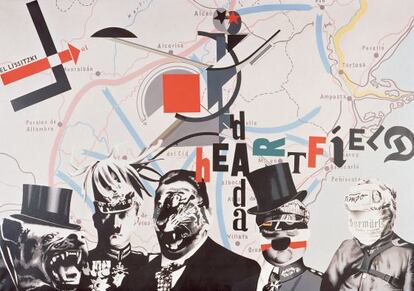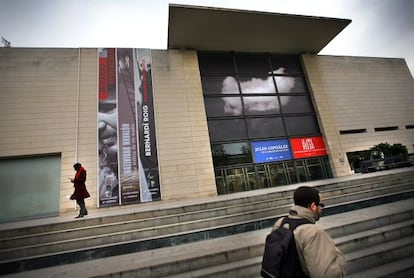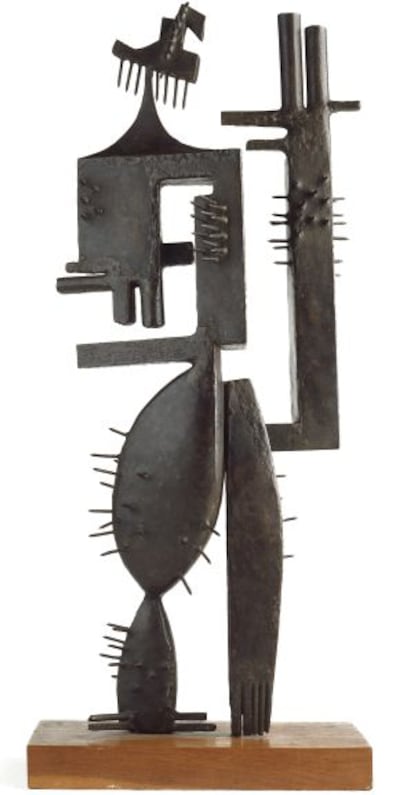A quarter century of being modern
Valencia’s groundbreaking IVAM center for art opened in 1989 Anniversary show brings out the museum’s best through 412 works

“Today is a historic date,” said Antonio Saura, the great informalist painter, at the inauguration of the Valencian Modern Art Institute (IVAM) exactly 25 years ago. Time soon proved him right, as one of Spain’s first modern and contemporary art centers quickly became an international reference point, despite having a tight budget from the word go.
Created by the government of Valencia as a showcase of newly achieved regional powers, IVAM developed a knack for detecting the dark angles that were bypassed by the art market and soon created a niche of its own made up of historic avant-garde movements, photography, pop art and informalism.
The museum’s growth over the last quarter-century is reflected in a new, commemorative exhibition that was inaugurated on Tuesday by Queen Sofía. The show aims to provide a bird’s eye view of art from the 20th century to the present through 412 artworks culled from the museum’s holdings. IVAM director Consuelo Ciscar assigned the critic and philosophy professor Francisco Jarauta to the daunting task of sifting through IVAM’s 11,000 artworks. The end result is a chronological journey through the work of some of the world’s leading artists.
The show goes on to
explore the intellectual tension created by World War I
The first of three rooms that hold the exhibition displays the wonderful Hombre-cactus (Cactus Man) by Julio González. “This room is devoted to the great avant-garde sculptor and his friends, with works by Torres-García, Brancusi, Matisse and David Smith,” explains the curator. In fact, the Julio González pieces were the original pillars that the museum’s collection was built upon. They were purchased by IVAM’s first director, Tomás Llorens, who believes this center contains “the most important collection of 20th-century art in Spain” after the Reina Sofía museum in Madrid, which he also headed.

The show goes on to explore the intellectual tension created by World War I, which resulted in futurism first and the Dada movement later. Artists represented in this room include Marcel Duchamp, Man Ray, Jean Arp and Sonia and Robert Delaunay. Next come the artistic-social solutions offered by Gropius’ Bauhaus, and experimental creations by Moholy-Nagy, Hélion and Alexander Calder. Manifestos, magazines, books and illustrations played a vital role in the avant-garde movements, and this too is reflected in the show.
“The IVAM made some smart purchases when Soviet power disintegrated,” says Jarauta, standing in front of the room containing Russian constructivism (Rodchenko, Stepanova, El Lissitzky and Malevich).
“At first the IVAM noticed important artists whom the market hadn’t yet put the spotlight on,” explains Vicente Todolí, former director of Tate Modern, who had previously headed IVAM between 1989 and 1996. Todolí says that his period at the helm of the Valencian institution was remarkably free of political interference.
However, politics do figure prominently in the spectacular room devoted to the Spanish Civil War and World War II, when posters and other related graphic material were at the service of political agitation and propaganda. Heartfield’s magazine covers for AIZ, Grosz’s Ecce homo and Renau’s anti-fascist photomontages share space with an allegorical sculpture by Lipchitz, the work of the Spanish collectives Equipo Crónica and Equipo Realidad, shots from the front lines by the photographer Agustí Centelles and a poster by Joan Miró.

Thus ends part one of the exhibition, the more experimental, documentary one. Part two is more conventional and it kicks off with a splendid painting by Antoni Tàpies, which hangs next to a sculpture by Anthony Caro.
European informalism and American abstract expressionism, which developed side by side during World War II, represent a return to matter. At the same time, the late 1950s and early 1960s gave birth to a geometric abstraction with constructivist roots and a tendency to experiment with the world of science. This part of the show focuses on works by Adolph Gottlieb, Lucio Fontana, Basque sculptor Jorge Oteiza and Tony Smith.
Visitors then move on to another one of IVAM’s strong points: pop art. Hamilton, Baldessari, Oldenburg, Rosenquist and Lindner are all represented here, as are other artists whose names are linked to the Leo Castelli gallery, such as Jasper Johns, Rauschenberg and Lichtenstein. Irony and social criticism pervade the Spanish pop art of Eduardo Arroyo, Juan Genovés and Luis Gordillo. This room ends with a critique of contemporary culture through the art of Richard Serra, Robert Smithson, Dieter Roth and Gerhard Richter.
The third room displays late 20th-century and early 21st-century work that reveals identity problems, collective memory gaps and a questioning of the various forms of resistance. There are installations and pieces by Christian Boltanski, Tony Oursler, Cristina Iglesias, Sean Scully, Juan Muñoz, Antoni Muntadas, Joan Fontcuberta, Markus Lúpertz and Georg Baselitz.
Ultimately, the exhibition seeks to “showcase” the IVAM’s own collection, in the words of Consuelo Ciscar, who is celebrating a decade at the helm of this art institution.
Colección del IVAM, XXV aniversario. Until May 4 at IVAM, C/ Guillem de Castro 118, Valencia. www.ivam.es
Tu suscripción se está usando en otro dispositivo
¿Quieres añadir otro usuario a tu suscripción?
Si continúas leyendo en este dispositivo, no se podrá leer en el otro.
FlechaTu suscripción se está usando en otro dispositivo y solo puedes acceder a EL PAÍS desde un dispositivo a la vez.
Si quieres compartir tu cuenta, cambia tu suscripción a la modalidad Premium, así podrás añadir otro usuario. Cada uno accederá con su propia cuenta de email, lo que os permitirá personalizar vuestra experiencia en EL PAÍS.
¿Tienes una suscripción de empresa? Accede aquí para contratar más cuentas.
En el caso de no saber quién está usando tu cuenta, te recomendamos cambiar tu contraseña aquí.
Si decides continuar compartiendo tu cuenta, este mensaje se mostrará en tu dispositivo y en el de la otra persona que está usando tu cuenta de forma indefinida, afectando a tu experiencia de lectura. Puedes consultar aquí los términos y condiciones de la suscripción digital.
Últimas noticias
The complicated life of Francesca Albanese: A rising figure in Italy but barred from every bank by Trump’s sanctions
How Japan is trying to avert ‘digital defeat’
Reinhard Genzel, Nobel laureate in physics: ‘One-minute videos will never give you the truth’
Pinochet’s victims grapple with José Antonio Kast’s rise in Chile
Most viewed
- Pablo Escobar’s hippos: A serious environmental problem, 40 years on
- Why we lost the habit of sleeping in two segments and how that changed our sense of time
- Trump’s obsession with putting his name on everything is unprecedented in the United States
- The Florida Keys tourist paradise is besieged by immigration agents: ‘We’ve never seen anything like this’
- Charles Dubouloz, mountaineering star, retires at 36 with a farewell tour inspired by Walter Bonatti









































